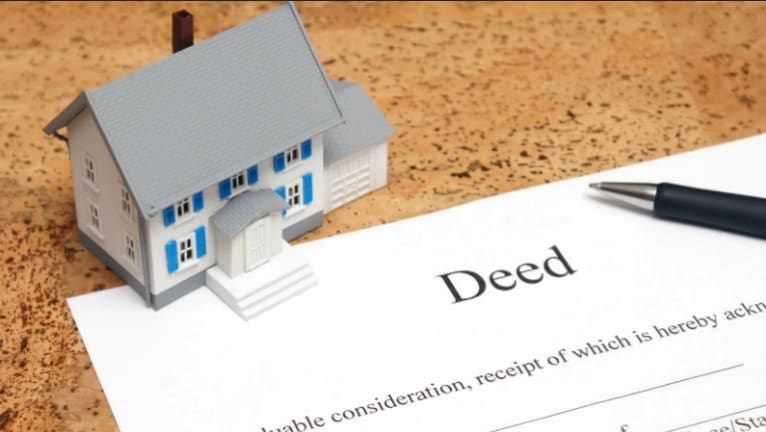What is a quitclaim deed?
A quitclaim deed is a document that transfers real estate ownership from one party to another.
Because it conveys legal ownership without providing title guarantees, a quitclaim deed allows you to donate or sell your property to another person swiftly and efficiently. The cost depends on whether you prepare the quitclaim deed yourself or engage a professional to do it for you, such as an attorney or a title company.

There are no assurances of title in quitclaim deeds. The proprietor does not guarantee that his title to the property is free of claims. As a result, quitclaims are commonly utilized to transfer property among family members. For example, parents might give their children the family house, or an owner can add his spouse to the title.
How Much Does It Cost to Transfer Property Deeds in the US?
To transfer property deeds, you need to pay the following fees:
- The deed preparation fee is from $25 to $150
- Transfer tax of around 1% of the property’s purchase price
- Gift tax to IRS (if you are gifting the property)
- Title insurance is from $500 to $1000, but it is not mandatory.
- Recording fees (buyer pays this fee upon filing from $50 to $225).
- Law firm services from $200 to $1500 (not mandatory).
A quitclaim can also resolve a title dispute or delete the name from the title. These modifications are frequently made part of a more significant transaction, such as a sale or dissolution. The quitclaim deed can be prepared by an attorney or title business involved in a transaction. A quitclaim document may appear straightforward, but because it transfers an enormous asset, such as your house or land, completing it incorrectly might result in significant legal implications. If you’re uncertain how to proceed, get competent legal guidance. A lawyer will charge a flat fee or an hourly rate to draft a quitclaim document. Prices differ by state and law firm but are often in the $200 to $1500 per degree range.
How much does it cost to transfer a deed in Florida in 2022?
Transferring a deed in Florida usually costs $0.4 per $100 (or a portion thereof). It typically costs between $50 and $250 to transfer a deed in Florida, depending on whether you submit your documents electronically or by mail and which documents are required.
Suppose you apply for your document using an e-recording service provider instead of submitting it by mail or in person at the comptroller’s office. In that case, additional costs may also be associated with that process.
If you are planning to transfer a deed in Florida, keeping these costs in mind is essential to budget appropriately for this process. However, with the proper preparation and assistance from experienced professionals, it can be easy to navigate this process and ensure that your transaction goes smoothly.
How to transfer a property deed in Tennessee?
To transfer a property deed in Tennessee, you usually pay as seller 1% of the final price in closing costs while the buyer is around 2%. Tennessee closing costs, deed preparation, and recording costs are, on average lower than other states.
Notary and Recording Fees
While each jurisdiction has its requirements for signing, a quitclaim deed is usually not enforceable unless it is signed before a notary. Registrars charge between $2 and $20 for each signature, depending on where you are, but loan closings and real estate deals will cost you more. After signing the quitclaim, you must register the transfer with the property records office and pay a nominal recording fee, which varies by county. Also, there is a deed stamping tax, a type of transfer tax. Many states impose a percentage of the purchase cost mentioned in the deeds as a tax payment. You must pay the county recorder for this deed stamp.
Uses of a Quitclaim Deed
Quitclaim documents are most commonly used to transfer assets among family members. For instance, an older parent may wish to pass down the family house to their child, while a newlywed wife may want to include her new spouse. In addition, ex-spouses can be removed following a divorce, business partners can be added or removed, and property can be transferred to a living trust.
Creating a quitclaim deed properly can take a long time and a lot of effort. You might save time consulting with an attorney or using an online document preparation service first. Remember that deeds are public records; therefore, naming a lawyer as the preparation gives the deed greater legitimacy.
Each State has its own set of rules for recording. For example, a document that will record in one State may not record in another state. Therefore, before submitting the document, double-check that it meets all of the county’s recording requirements.
States with no real estate transfer taxes
The US is a vast country, and as such, many states have unique tax policies regarding real estate. While some states levy a real estate transfer tax when a property title changes hands, several do not have this kind of tax.
The US states that do not have a real estate transfer tax include Alaska, Idaho, Indiana, Louisiana, Kansas, Mississippi, Missouri, Montana, New Mexico, North Dakota, Oregon (in most counties), Texas, Utah, and Wyoming. This may be because these states already have low property taxes or no income or sales taxes.
These states instead rely on other forms of taxation to generate revenue for government services. For example, Alaska taxes oil production and natural resources such as timber and minerals. Meanwhile, states like Texas raise significant revenues from sales taxes and tourism dollars.
Overall, whether a state has no real estate transfer tax or a different policy depends on its unique economic situation and priorities. Nevertheless, there are many options available across the country for those looking to buy or sell property in the US without being weighed down by additional fees and costs associated with real estate transfers.
